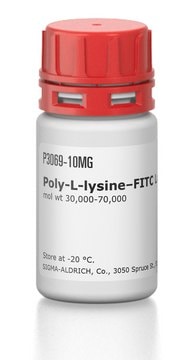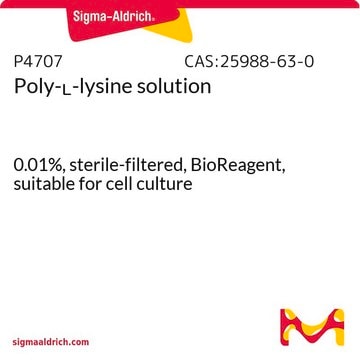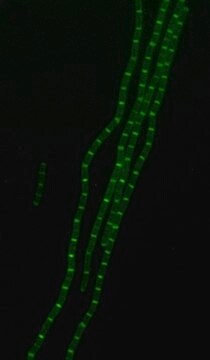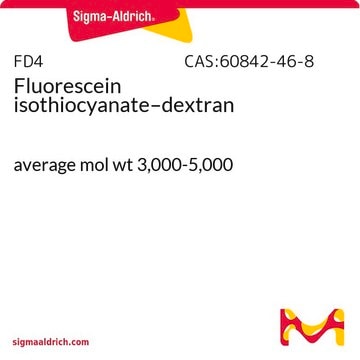The viscosity average molecular weight (Mv) is determined for each lot of this product. However, there is a distribution of molecular weights around that Mv. As a result, the molar concentration is not applicable. The typical degree of polymerization (DP) for this material is approximately 100 and the typical degree of substitution (moles of FITC per mole of lysine) is approximately 0.007 or 7 per 1000; essentially 7 of 10 Poly-L-Lysine molecules contain one FITC label. The concentration of the solution may be most accurately determined by precisely weighing the sample and precisely determining the volume, so that the sample may be reported as mg/mL. The degree of substitution and degree of polymerization are lot specific and reported in the product Certificate of Analysis. Please see the link below to review a sample of lot specific Certificate:
https://www.sigmaaldrich.com/product/sigma/p3543#product-documentation
P3543
Poly-L-lysine–FITC Labeled
mol wt 15,000-30,000
Synonim(y):
Poli-L-lizyna znakowana fluoresceiną
About This Item
Polecane produkty
Formularz
powder
masa cząsteczkowa
precursor poly-L-lysine • HBr 15,000-30,000
15,000-30,000
zakres etykietowania
0.003-0.01 mol FITC per mol lysine monomer
kolor
yellow to orange
temp. przechowywania
−20°C
Szukasz podobnych produktów? Odwiedź Przewodnik dotyczący porównywania produktów
Powiązane kategorie
Inne uwagi
Kod klasy składowania
11 - Combustible Solids
Klasa zagrożenia wodnego (WGK)
WGK 3
Temperatura zapłonu (°F)
Not applicable
Temperatura zapłonu (°C)
Not applicable
Środki ochrony indywidualnej
Eyeshields, Gloves, type N95 (US)
Wybierz jedną z najnowszych wersji:
Certyfikaty analizy (CoA)
Nie widzisz odpowiedniej wersji?
Jeśli potrzebujesz konkretnej wersji, możesz wyszukać konkretny certyfikat według numeru partii lub serii.
Masz już ten produkt?
Dokumenty związane z niedawno zakupionymi produktami zostały zamieszczone w Bibliotece dokumentów.
Klienci oglądali również te produkty
Produkty
Humankind has utilized protein materials throughout its existence, starting with the use of materials such as wool and silk for warmth and protection from the elements and continuing with the use of recombinant DNA techniques to synthesize proteins with unique and useful properties.
-
ow do you determine the peptide concentration of a small scoop in solution? I am reading the absorbance at 495nm to read the fluorophore but I don't know how to convert that Absorbance value to a meaningful mg/mL or molarity concentration without an e.c.
1 answer-
Helpful?
-
-
How much FITC quantity or weight percentage is present per mg of the mixture? If 10 mg of the product is weighed out, what portion of the weight corresponds to the PLL?
1 answer-
The FITC quantity present per mg of the mixture is 0.016 mg, which corresponds to approximately 1.6% of the weight. If 10 mg of the product is weighed out, the portion of the weight corresponding to the PLL is approximately 9.84 mg.
Helpful?
-
Active Filters
Nasz zespół naukowców ma doświadczenie we wszystkich obszarach badań, w tym w naukach przyrodniczych, materiałoznawstwie, syntezie chemicznej, chromatografii, analityce i wielu innych dziedzinach.
Skontaktuj się z zespołem ds. pomocy technicznej









